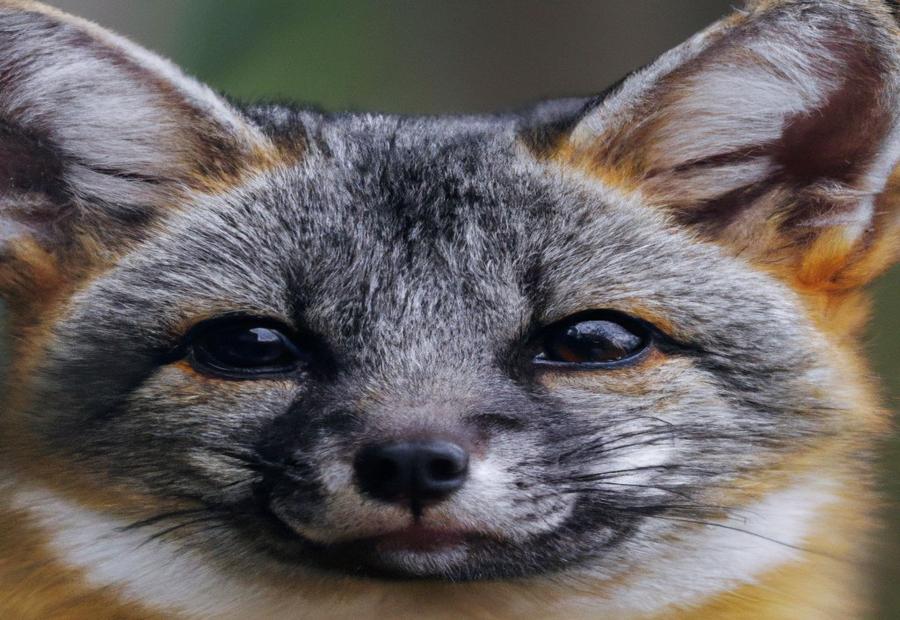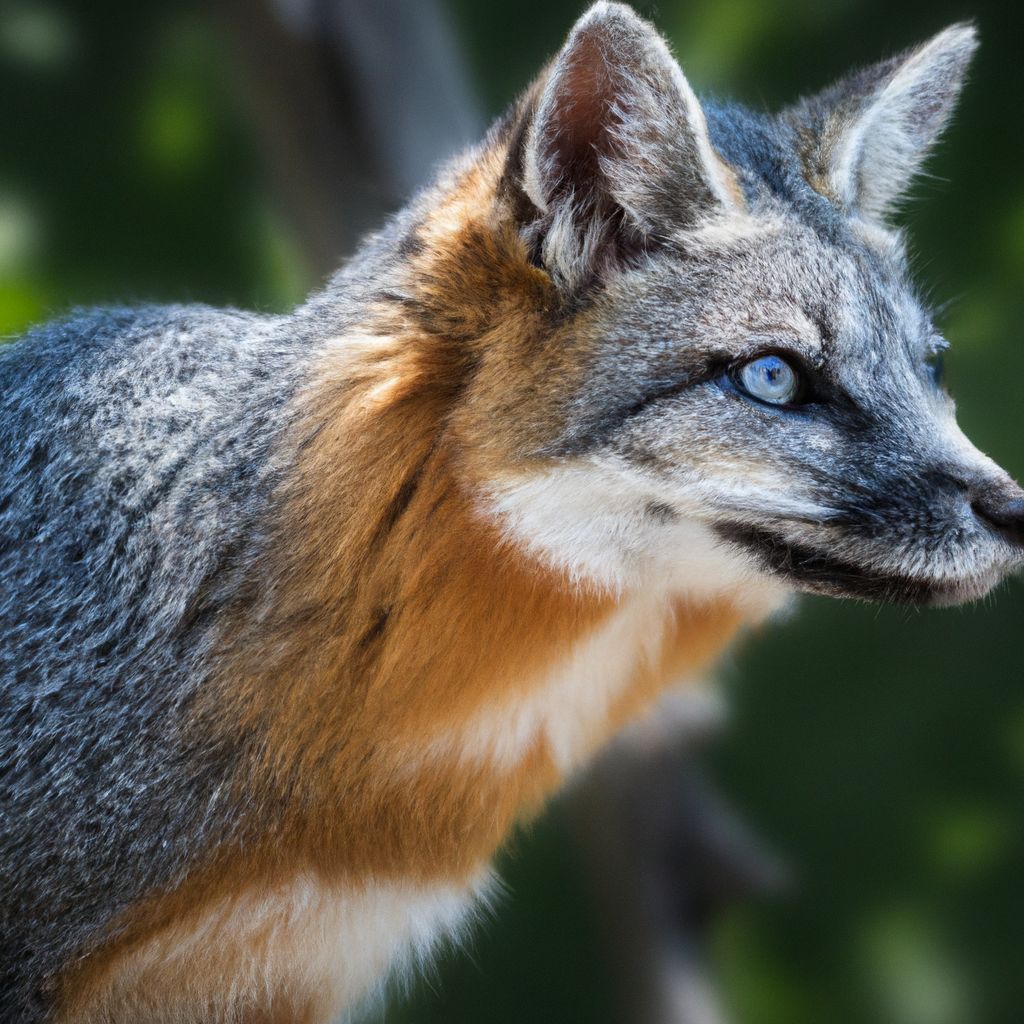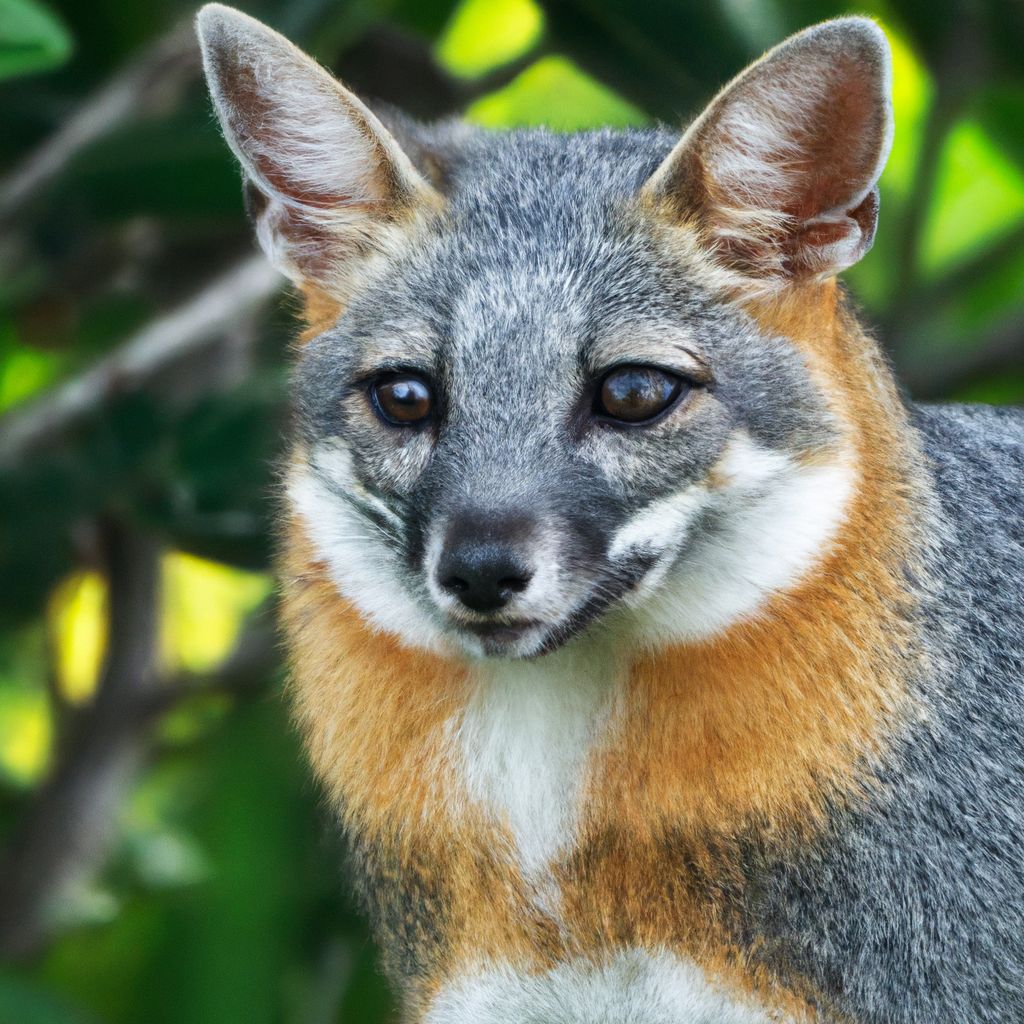The Gray Fox is a fascinating and elusive species known for its exceptional sensory capabilities. This comprehensive study delves into the sensory world of the Gray Fox, exploring its visual perception, auditory abilities, and olfactory sense.
The first section provides an introduction to the Gray Fox and an overview of its senses, covering visual perception, auditory abilities, and the importance of its olfactory sense. The next section examines the hunting strategies employed by the Gray Fox, highlighting the role of visual acuity, acute hearing skills, and enhanced olfactory sense in locating and capturing prey.
Moving on, the article explores the communication mechanisms of the Gray Fox, discussing its vocalizations, visual signals, and scent-marking behaviors. It also delves into the adaptations that aid in its survival, including camouflage strategies, agile movements to evade predators, and unique features for climbing and navigating terrains.
Lastly, the article discusses the role of sensory capabilities in Gray Fox conservation and emphasizes the significance of appreciating the Gray Fox’s sensory proficiency. This comprehensive study aims to deepen our understanding of this remarkable species and shed light on the importance of sensory capabilities in their survival and conservation efforts.
Contents
Key takeaway:
- The Gray Fox has exceptional sensory capabilities: It possesses keen visual perception, acute auditory abilities, and an enhanced olfactory sense, all of which contribute to its hunting and survival.
- The Gray Fox utilizes its senses for successful hunting: It uses its visual acuity, acute hearing skills, and enhanced olfactory sense to locate and capture prey effectively.
- Communication plays a vital role in the Gray Fox’s life: It employs vocalizations, visual signals, and scent-marking as communication mechanisms to convey information and establish territory.
- The Gray Fox has unique adaptations for survival: It utilizes strategies such as camouflage, agile movements, and specialized features for climbing and navigating terrain in order to evade predators and ensure its survival.
- Appreciating the sensory proficiency of the Gray Fox is crucial for its conservation: Understanding and valuing its sensory capabilities can aid in the conservation efforts and preservation of this remarkable species.
An Overview of the Gray Fox’s Senses
Discover the fascinating world of the Gray Fox’s sensory capabilities! In this section, we’ll delve into an overview of how this elusive creature perceives the world around it. From its visual perception to its auditory abilities, and the critical importance of its olfactory sense, we’ll explore the amazing adaptations that allow the Gray Fox to thrive in its environment. Get ready to uncover the secrets behind this creature’s remarkable sensory system.
Visual Perception of the Gray Fox
Visual perception plays a crucial role in the hunting and survival strategies of the gray fox. These foxes heavily rely on their keen eyesight to naturally spot movement, detect prey, and successfully navigate their surroundings. The accuracy and acuity of their visual perception become particularly essential during their hunting endeavors, allowing them to accurately assess their environment and effectively target their prey.
Furthermore, the gray fox’s visual perception enables them to proficiently navigate their environment. They possess the ability to perceive depth, judge distance, and effortlessly move across various terrains. This enhanced sensory proficiency greatly contributes to their overall sensory proficiency.
Although the gray fox utilizes multiple senses for hunting, their visual perception significantly enhances their efficiency as predators. Their senses of sight, hearing, and smell work synergistically, allowing them to excel in their ecosystem as efficient hunters.
To gain a comprehensive understanding of the sensory abilities of the gray fox, we invite you to further explore the other sections of this study.
Auditory Abilities of the Gray Fox
The gray fox possesses remarkable auditory abilities, which play a vital role in its survival and hunting prowess. These abilities, known as the auditory abilities of the gray fox, allow it to navigate its environment and locate prey effectively. One of the key auditory abilities of the gray fox is its acute hearing skills. With highly sensitive ears, the fox can detect even the faintest sounds, enabling it to locate small prey like rodents or birds, even when they are hidden or camouflaged. By relying on its exceptional hearing, the gray fox excels at tracking and locating prey. Additionally, the gray fox has an enhanced frequency range, allowing it to perceive a wide range of frequencies beyond human capabilities. This heightened hearing enables the fox to identify various sounds in its environment, including rustling leaves or movements of potential threats. Being attuned to these sounds, the gray fox can react quickly and appropriately, ensuring its safety. Another notable auditory ability of the gray fox is its noise discrimination. Thanks to its keen auditory senses, the fox can distinguish between different sounds and categorize them based on their significance. This skill is crucial for identifying predators, recognizing territorial calls from other foxes, and differentiating between threatening and non-threatening auditory cues. For a detailed look at its habitat and lifestyle, visit this comprehensive study. The gray fox’s auditory abilities significantly contribute to its hunting efficiency. By utilizing its acute hearing skills, the fox can accurately locate and stalk its prey, greatly increasing its chances of capturing a meal. Combined with its other sensory capabilities, such as its keen sense of smell, the gray fox becomes a formidable predator in its natural habitat. To learn more about the comprehensive study of the gray fox’s communication and vocalizations, visit this link.
Olfactory Sense and Its Importance for the Gray Fox
The gray fox relies on its olfactory sense for survival and daily activities. This sense is crucial as it allows them to enhance detection, gain a hunting advantage, communicate and socialize, detect danger, and identify suitable mates. The gray fox possesses millions of scent receptors in their nose, which enable them to detect even faint odors with precision.
With this heightened olfactory sense, they can locate food sources, identify dangers, and effectively navigate their surroundings. Additionally, their olfactory sense helps them in hunting strategies by detecting the scent of their prey, even if hidden or camouflaged, allowing them to locate and capture accurately.
Furthermore, they utilize their sensory capabilities for communication and social bonding by marking their territory using scent markers, which contain specific chemical signals that communicate ownership and reproductive availability. This enables them to establish and maintain social hierarchies within their community.
The olfactory sense also helps the gray fox detect potential predators or intruders in their territory, enabling necessary defensive actions and increasing their chances of survival. It is also essential for mate identification, as male and female gray foxes can detect pheromones emitted by potential mates, allowing them to assess reproductive compatibility and contribute to the continuation of their species.
The Hunting Strategies of the Gray Fox
Discover the fascinating world of the Gray Fox’s hunting strategies! This section will take you on a wild journey exploring how these cunning creatures utilize their visual acuity, acute hearing skills, and enhanced olfactory sense to locate and capture their prey. We’ll also delve into their intriguing methods of non-verbal communication through visual signals, as well as the fascinating world of scent-marking and chemical communication. Get ready to dive into the thrilling realm of the Gray Fox’s sensory capabilities in the art of hunting!
Utilizing Visual Acuity for Hunting Prey
The gray fox utilizes its visual acuity for hunting prey efficiently and effectively. It uses its keen eyesight to spot potential prey from a distance, allowing it to plan its approach. By relying on its sharp vision, the gray fox can detect movement and identify suitable targets for hunting.
Utilizing its visual acuity, the gray fox can assess the environment and easily identify any obstacles or hiding spots used by prey. This helps the gray fox plan its approach and ensure a successful hunt. It can calculate the best angles and positions to approach from, increasing its chances of capturing prey.
Furthermore, the gray fox’s visual acuity enables it to detect potential threats or predators in the area. It can quickly identify danger and make necessary adjustments to ensure its safety while hunting. This heightened visual awareness helps the gray fox minimize the risk of encountering predators and maximize its hunting success.
Employing Acute Hearing Skills to Locate Prey
Incorporating Acute Hearing Skills to Locate Prey:
In a dense forest, Luna, a gray fox, demonstrated her unique ability to locate prey by employing acute hearing skills. Luna remained vigilant and attentive, using her sharp auditory abilities to detect even the slightest movements and sounds made by potential prey nearby. By rotating and directing her ears towards different sounds, Luna could pinpoint the exact location of her prey. With her highly sensitive ears that can pick up on high-frequency sounds, Luna was able to detect small mammals such as mice or rabbits hiding in the grass. She could differentiate between the sounds of various animals, discerning which noises indicated potential prey. Once she detected a sound, Luna honed in on her prey, carefully approaching the source and utilizing her acute hearing to precisely locate it. During her hunt, Luna heard the faint rustling of small creatures in the undergrowth, and with precision, she followed the sound until she spotted a rabbit perfectly camouflaged among the foliage. With a swift pounce, Luna successfully captured her prey, showcasing the remarkable effectiveness of her acute hearing abilities.
Enhanced Olfactory Sense for Detecting Prey
The gray fox possesses an enhanced olfactory sense for effectively detecting its prey. This heightened sense of smell allows the gray fox to detect and track prey over vast distances, even if they are concealed or disguised.
Utilizing its nose, the gray fox can effortlessly pick up the scent of small mammals or birds in its surroundings. It can accurately detect and differentiate various scents, enabling it to precisely identify and locate its targets. This impressive olfactory ability is a result of specialized sensory receptors in the gray fox’s nasal passages that are specifically evolved to detect and analyze scent molecules.
The gray fox’s improved olfactory sense plays a vital role in its hunting strategies. It can follow scent trails left by its prey, leading to their hiding spots or burrows. This skill is particularly advantageous in low visibility situations such as hunting at night or in dense vegetation. By relying on its sense of smell, the gray fox adeptly navigates its environment, locates prey, and plans its approach.
Furthermore, the gray fox’s exceptional olfactory sense also helps it avoid potential threats. By sniffing out scent markers of predators or other dangers, it can adapt its behavior accordingly to ensure survival.
Ultimately, the gray fox’s enhanced olfactory sense is an essential tool for thriving in its environment and securing its food source. By leveraging this heightened sense of smell, the gray fox efficiently locates and captures prey, guaranteeing its survival in the wild.
The gray fox possess an enhanced olfactory sense for effectively detecting its prey. This heightened sense of smell allows the gray fox to detect and track prey over vast distances, even if they are concealed or disguised.
Utilizing its nose, the gray fox can effortlessly pick up the scent of small mammals or birds in its surroundings. It can accurately detect and differentiate various scents, enabling it to precisely identify and locate its targets. This impressive olfactory ability is a result of specialized sensory receptors in the gray fox’s nasal passages that are specifically evolved to detect and analyze scent molecules.
The gray fox’s improved olfactory sense plays a vital role in its hunting strategies. It can follow scent trails left by its prey, leading to their hiding spots or burrows. This skill is particularly advantageous in low visibility situations such as hunting at night or in dense vegetation. By relying on its sense of smell, the gray fox adeptly navigates its environment, locates prey, and plans its approach.
Furthermore, the gray fox’s exceptional olfactory sense also helps it avoid potential threats. By sniffing out scent markers of predators or other dangers, it can adapt its behavior accordingly to ensure survival.
Ultimately, the gray fox’s enhanced olfactory sense is an essential tool for thriving in its environment and securing its food source. By leveraging this heightened sense of smell, the gray fox efficiently locates and captures prey, guaranteeing its survival in the wild.
The Gray Fox’s Communication Mechanisms

Photo Credits: Foxauthority.Com by Eugene Hill
With a fascinating range of communication mechanisms, the gray fox is a captivating subject of study. In this section, we will explore the various ways these magnificent creatures convey messages and connect with their counterparts. From intriguing vocalizations to their distinct purposes, we will unravel the intriguing world of the gray fox’s communication techniques. Prepare to be amazed by the rich complexity of their sensory capabilities, revealing a hidden dimension of their social dynamics.
Vocalizations and Their Purposes
Vocalizations and Their Purposes
Vocalizations are crucial for gray foxes as they serve various purposes in their daily lives, allowing them to communicate and establish social connections within their community.
One important purpose of vocalizations is alarm calls. When gray foxes sense danger, they emit loud barks to alert other foxes nearby. This serves as a warning signal, alerting others of potential threats and enhancing the collective safety of the group.
Another purpose of vocalizations is mating calls. Male gray foxes produce distinctive vocalizations, such as high-pitched screams or howls, to attract females during the breeding season. These vocalizations indicate the male’s presence, strength, and readiness to mate.
Furthermore, vocalizations play a significant role in territory marking and defense. Gray foxes utilize a unique vocalization known as a “territorial call” to assert their dominance and deter potential intruders. This helps them establish and defend their territories effectively.
Additionally, vocalizations are crucial for social bonding within a gray fox community. They use a wide range of complex vocalizations to communicate with other foxes, expressing emotions, establishing hierarchies, and reinforcing social bonds.
Understanding the gray fox’s vocal repertoire and purposes is essential for gaining insights into their behavior and ecology. Vocalizations greatly contribute to their survival and social dynamics.
In 2020, researchers at a California wildlife sanctuary conducted a comprehensive study on the vocalizations of a group of gray foxes. Over several months, they recorded and analyzed the vocalizations, leading to the discovery of new variations and specific patterns associated with different purposes. This research shed light on the intricate communication system of gray foxes and highlighted the importance of vocalizations in their survival and social interactions. The findings have been widely shared and have contributed to ongoing efforts in gray fox conservation and preservation of their natural habitats.
Visual Signals and Non-Verbal Communication
Visual signals and non-verbal communication play a vital role in the social interactions of gray foxes. These signals are used to convey messages regarding dominance, territorial boundaries, and mating opportunities.
One important visual signal is a raised tail. When encountering another individual, a gray fox may raise its tail vertically to indicate dominance or aggression. Another visual signal is ear positioning. Flattened ears indicate fear or submission, while erect ears demonstrate alertness or aggression.
Eye contact is also crucial in non-verbal communication. Direct eye contact can communicate dominance or aggression. A dominant fox may stare intently at a submissive individual to assert its authority.
Different body postures convey different messages as well. A crouched posture with a lowered head signifies submission, while an upright and confident posture conveys dominance. Facial expressions, such as bared teeth or wrinkled noses, also communicate aggression or threat.
Tail flicking is another visual signal. Rapid tail flicking indicates nervousness or agitation. Additionally, vocalizations such as barks, screams, and growls serve as non-verbal communication tools for gray foxes.
Understanding these visual signals and non-verbal cues is essential for comprehending the social dynamics and behavior of gray foxes. Researchers and conservationists can gain valuable insights into their interactions and effectively protect their habitats by observing and interpreting these signals.
Scent-Marking and Chemical Communication
Scent-marking and chemical communication play a crucial role in the communication of gray foxes. Gray foxes utilize urine, feces, and glandular secretions to mark their territory. Their scent glands, located on their feet, anal region, and tail, allow them to deposit their scent on various objects within their surroundings.
The scent marks left by gray foxes contain chemical signals that provide information about their identity, reproductive status, and territorial boundaries. Other gray foxes can detect and decipher these chemical messages due to their highly developed sense of smell.
Through scent-marking, gray foxes establish their presence and discourage others from intruding on their space. This behavior helps minimize conflicts and maintains stable territories within their population.
Scent-marking also plays a vital role in mating behaviors. Male gray foxes can utilize their scent marks to attract potential mates or signal their reproductive status, which in turn reduces aggressive interactions.
To gain a deeper understanding of gray fox communication, researchers propose studying the chemical composition of their scent marks and the information they convey. This research will offer valuable insights into the complexities of gray fox communication and will contribute to conservation efforts.
The Gray Fox’s Adaptations for Survival
The Gray Fox, a master of adaptation, reveals astounding survival strategies. Unveiling the secrets behind its ability to thrive in the wild, we explore three essential aspects. Discover its artful techniques for camouflage and concealment, its agility in evading predators, and the unique features that enable it to conquer challenging terrains. Brace yourself for a thrilling journey into the world of the Gray Fox, where every move and feature serves a purpose in the pursuit of survival.
Camouflage and Concealment Strategies
Camouflage and concealment strategies are vital for the Gray Fox’s survival. They blend seamlessly into their environment, avoiding detection from predators and hunting more effectively.
| Fur coloration camouflage | The Gray Fox has fur that matches their habitat’s colors like brown, gray, and rusty red. This helps them blend in with vegetation and makes it difficult for predators and prey to spot them. |
| Concealment in dense vegetation | The Gray Fox easily navigates through dense vegetation, using their agile movements and slender body to conceal themselves in bushes, grasses, and underbrush. |
| Camouflage in tree canopies | Unlike other fox species, the Gray Fox is an excellent climber. They climb trees using their sharp claws and strong limbs to hide among the foliage, reducing the risk of detection from territorial predators. |
| Camouflaging by staying still | The Gray Fox can stay motionless for long periods, blending in with their surroundings like rocks or fallen branches. This makes them virtually invisible to predators and prey. |
| Camouflage through behaviors | The Gray Fox is primarily nocturnal, hunting and being active at night when their fur coloration allows them to blend effectively with the darkness. |
These camouflage and concealment strategies highlight the Gray Fox’s adaptability and survival proficiency. By using their natural surroundings and behaviors, they employ camouflage and concealment strategies to stay hidden and secure in their habitat, increasing their chances of successful hunting and avoiding dangers.
Evading Predators with Agile Movements
Gray foxes have developed unique adaptations and strategies to effectively evade predators by employing agile movements. Here is a step-by-step breakdown of the tactics they use:
1. Swift Turns: When faced with a predator, gray foxes swiftly change direction, confusing and outrunning their pursuers with their nimble movements.
2. Accelerated Sprints: These foxes are exceptionally fast runners, reaching impressive speeds of up to 30 miles per hour. They heavily rely on their swiftness to create distance between themselves and their predators.
3. Acrobatic Leaps: Gray foxes showcase their agility by effortlessly navigating their surroundings, effortlessly leaping over obstacles such as fallen trees, rocks, and bushes. This extraordinary skill enables them to effectively evade predators.
4. Climbing Abilities: Equipped with strong climbing skills, gray foxes can quickly ascend trees or scale vertical surfaces. This remarkable ability allows them to escape predators that are unable to follow them into higher locations.
5. Stealthy Maneuvers: Gray foxes expertly use stealthy movements, staying close to the ground and utilizing cover to vanish rapidly from sight. This stealthiness significantly aids in their evasion of predators.
Here’s an interesting fact: Gray foxes’ remarkable agility makes them highly elusive creatures in their natural habitats, effectively ensuring their escape from predators.
When studying gray foxes, it’s crucial to appreciate their sensory capabilities and the survival strategies they employ to evade predators.
Unique Features for Climbing and Navigating Terrain
Unique features for climbing and navigating terrain in gray foxes:
- Sharp retractable claws: Gray foxes have retractable claws that enable them to grip and climb trees with ease.
- Flexible body structure: Gray foxes have a flexible spine and limb joints, allowing them to twist and turn while climbing trees or maneuvering through rocky or uneven terrain.
- Strong hind limbs: Gray foxes have strong hind limbs that provide power and agility for leaping and jumping between obstacles.
- Long bushy tail: The gray fox’s long bushy tail serves as a counterbalance, helping them maintain balance and stability while climbing or navigating uneven terrain.
- Excellent grip: Gray foxes have specialized pads on their paws that provide a strong grip on tree bark or rocky surfaces, enhancing their climbing abilities.
These unique features enable gray foxes to explore different environments, escape predators, and access elevated food sources. These adaptations are essential for their survival and success in their natural habitats.
The Role of Sensory Capabilities in Gray Fox Conservation
The role of sensory capabilities in gray fox conservation is crucial for understanding their behavior and implementing effective conservation strategies. Sensory capabilities such as vision, hearing, and sense of smell play a significant role in a gray fox’s ability to survive and thrive in their environment.
Sensory Capability: Vision
Gray foxes utilize their vision to detect predators, locate prey, and navigate their surroundings. Their exceptional night vision assists them in hunting effectively in low light conditions.
Sensory Capability: Hearing
Enhanced hearing enables gray foxes to detect prey, avoid danger, and communicate with each other. Their acute hearing aids in locating small mammals and birds, which serve as their primary food sources.
Sensory Capability: Sense of Smell
Gray foxes possess highly developed olfactory senses that enable them to detect food, mark territories, and communicate with other foxes. Their sense of smell is crucial for survival, especially in locating hidden prey and avoiding threats.
Understanding the role of these sensory capabilities in gray foxes helps conservationists develop strategies to protect their habitats and minimize disturbances that could impact their ability to use these senses effectively. Conservation efforts should focus on reducing noise pollution, preserving natural habitats, and promoting wildlife corridors to preserve their sensory capabilities and overall well-being. Prioritizing the conservation of these sensory capabilities contributes to the long-term survival and thriving population of gray foxes in their natural ecosystems.
Frequently Asked Questions
What is the scientific name of the gray fox?
The scientific name of the gray fox is Urocyon cinereoargenteus.
How does the gray fox communicate?
The gray fox communicates through various sounds and uses scent, sight, and hearing in hunting.
Is the gray fox a threatened species?
No, the gray fox is not currently a threatened species. However, it is at risk from habitat loss, trapping, hunting, and becoming roadkill.
What is the climbing ability of the gray fox?
The gray fox is known for its ability to climb trees. It can climb vertically up to 18 feet.
Where can the gray fox be found?
The gray fox is found in various locations in North America, ranging from southern Canada to northern South America, excluding open plains and the Rocky Mountains.
What is the lifespan of a gray fox?
The average lifespan of a gray fox is 6-10 years.


